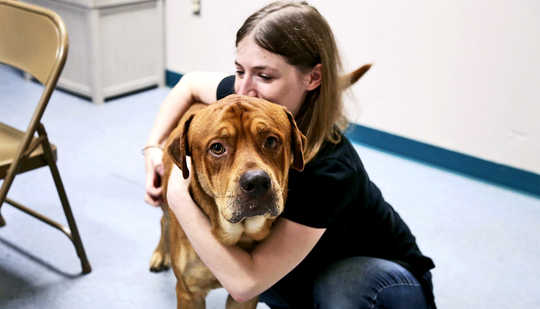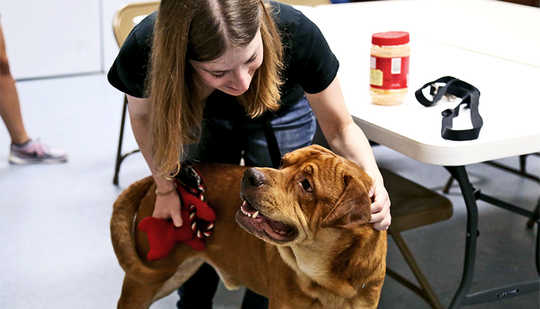
Psychologists who study how people pick their spouses have turned their attention to another important relationship: choosing a canine companion.
They recently found that, when it comes to puppy love, the heart doesn’t always know what it wants.
The researchers based their results, which could help improve the pet adoption process, on data from a working animal shelter.
Picking a pet from dog shelters
“What we show in this study is that what people say they want in a dog isn’t always in line with what they choose,” says Samantha Cohen, who led the study as a PhD student in the psychological and brain sciences department at Indiana University-Bloomington. “By focusing on a subset of desired traits, rather than everything a visitor says, I believe we can make animal adoption more efficient and successful.”
As a member of the lab of study coauthor Peter Todd, Cohen conducted the study while also volunteering as an adoption counselor at an animal shelter.
“It was my responsibility to match dogs to people based on their preferences, but I often noticed that visitors would ultimately adopt some other dog than my original suggestion,” Cohen says. “This study provides a reason: Only some desired traits tend to be fulfilled above chance, which means they may have a larger impact on dog selection.”

(Credit: Cadence L. Baugh Chang/Indiana U.)
The researchers categorized dogs based upon 13 traits: age, sex, color, size, purebred status, previous training, nervousness, protectiveness, intelligence, excitability, energy level, playfulness, and friendliness. They surveyed the preferences of 1,229 people who visited dogs at an animal shelter, including 145 who decided to make an adoption.
A similar disconnect has been found in research on speed dating Todd led, which has shown that people’s stated romantic preferences tend not to match the partners they choose.
Although most participants in the dog adoption study listed many traits they preferred—with “friendliness” as the most popular—they ultimately selected dogs most consistent with just a few preferences, like age and playfulness, suggesting that others, like color or purebred status, exerted less influence on decision-making.
There was also another parallel to the world of dating. In short: Looks matter.
“As multiple psychologists have shown in speed-dating experiments, physical attractiveness is very important,” Cohen says. “Most people think they’ve got a handsome or good-looking dog.”
Issues potential pet-owners face
In the article, Cohen outlines some challenges facing aspiring dog-owners:
- Focusing on “the one”: Although adopters often came to the shelter with a vision of the perfect pet, Cohen says many risked missing a good match due to overemphasis on specific physical and personality traits. For example, an adopter who wants an Irish wolfhound because they’re large, loyal, and light shedders might fail to consider a non-purebred with the same qualities.
- Mismatched perceptions: Surprisingly, adopters and shelters often used different traits to describe the same dog. These included subjective traits, such as obedience and playfulness, as well as seemingly objective traits, such as color.
- Missed signals: People who have never had a dog may not grasp the implications of certain behaviors. A dog seen as “playful” at the shelter may come across as “destructive” in a small home, for example.
- Performance anxiety: Shelters are high-stress environments for dogs, whose personalities may shift when they’re more relaxed at home. Picking a dog based upon personality at the shelter is akin to choosing a date based on how well they perform while public speaking, Cohen says.
To improve pet adoptions, Cohen says animal shelters need to know that people tend to rely on certain traits more strongly when choosing a dog, which might make it easier to match adopters to dogs.
She also suggests shelters consider interventions, such as temporary placement in a calmer environment, to help stressed or under-socialized dogs put their best paw forward, showing their typical level of desirable traits, such as friendliness.
Finally, Cohen advises caution about online adoption, since adopters are dependent upon someone else’s description of the dogs. She suggests users limit their search criteria to their most desired traits to avoid filtering out a good match based upon less important preferences.
The journal appears in Behavior Research Methods. Support for the study came, in part, from an Indiana University Graduate and Professional Student Government Research Award.
Source: Indiana University
Books on Pets from Amazon's Best Sellers list
"The Beginner's Guide to Dog Agility"
by Laurie Leach
This book is a comprehensive guide to dog agility, including training techniques, equipment, and competition rules. The book includes step-by-step instructions for training and competing in agility, as well as advice for selecting the right dog and equipment.
Click for more info or to order
"Zak George's Dog Training Revolution: The Complete Guide to Raising the Perfect Pet with Love"
by Zak George and Dina Roth Port
In this book, Zak George offers a comprehensive guide to dog training, including positive reinforcement techniques and advice for addressing common behavior issues. The book also includes information on selecting the right dog and preparing for the arrival of a new pet.
Click for more info or to order
"The Genius of Dogs: How Dogs Are Smarter than You Think"
by Brian Hare and Vanessa Woods
In this book, authors Brian Hare and Vanessa Woods explore the cognitive abilities of dogs and their unique relationship with humans. The book includes information on the science behind dog intelligence, as well as tips for enhancing the bond between dogs and their owners.
Click for more info or to order
"The Happy Puppy Handbook: Your Definitive Guide to Puppy Care and Early Training"
by Pippa Mattinson
This book is a comprehensive guide to puppy care and early training, including advice for selecting the right puppy, training techniques, and health and nutrition information. The book also includes tips for socializing puppies and preparing for their arrival.
Click for more info or to order
























